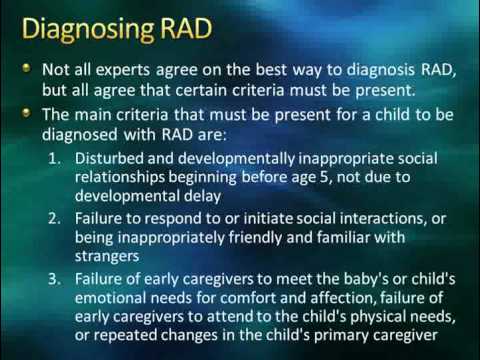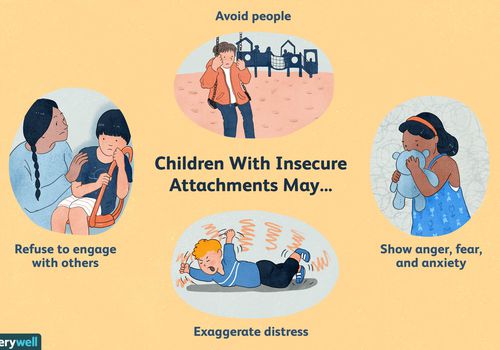What is Attachment Disorder?

Reactive attachment disorder (RAD), also known as separation anxiety, is a condition that most often occurs in infants who are not breastfed or do not form secure, emotional attachments with their caregivers before the age of five. Infants with RAD typically respond to emotional stimulation with physical symptoms such as crying, shaking, head shaking, or stomach upset. An infant with RAD does not have the ability to express his or her feelings verbally or through actions.
The exact causes of attachment disorder have not been pinpointed
However, there is some evidence that it can have a genetic component. It has also been shown to be influenced by environmental factors like being raised by divorced parents. Reactive attachment disorder is sometimes called "angry baby syndrome" due to the intense distress and discomfort babies with RAD often exhibit, including hyperactivity, irritability, depression, sleep problems, temper tantrums, and anxiety.
There is no clear evidence as to whether reactive attachment disorder has any relationship to temperament or intelligence. If one parent has RAD and the other does not, it is possible that the other parent's temperament and intelligence are irrelevant to the development of the child with RAD. However, if both parents have RAD, it is more likely that their personalities are related to the child's development.
There are several symptoms associated with attachment disorder: crying when separated from the parent; becoming clingy; crying when separated from the caregiver; being very sensitive to the environment; and being unusually sensitive to temperature changes. When a parent begins to physically punish a child for inappropriate behavior, this may result in the child losing the ability to form secure emotional bonds. This makes the individual more likely to become clingy when they get home. Reactive attachment disorder may also be inherited from a biological parent.

RAD can interfere with normal development, but it can also lead to behavioral therapy that helps the child cope with the disorder
There are several treatments available, including dietary changes, behavioral training techniques, hypnotherapy, biofeedback therapy, massage therapy, social skills training, exercise programs, and cognitive behavioral therapy.
Attachment disorder in infants is caused by unresolved issues. When these issues are addressed in the early years of life, children are able to form secure relationships with their caregivers. and enjoy a healthy attachment to caregivers.
Some of the therapies used to treat attachment disorder involve: desensitization, exposure therapy, desensitizing and counter-conditioning, parent training, cognitive behavioral therapy, cognitive restructuring, behavior therapy, parent support, parenting programs, alternative therapy, parent-child training, attachment disorder treatment plans, attachment disorder management, and psychodynamic therapy. Medications can also be prescribed to alleviate anxiety and decrease stress, increase emotional security, reduce anxiety and improve the child's ability to form a secure attachment. Treatment will be effective if it addresses all of these issues and focuses on developing the individual's ability to develop secure relationships.
An attachment disorder treatment plan should include: a plan that provides for the emotional health of the infant and his/her caregivers; a plan that addresses the caregiver's ability to provide emotional support and security for the infant; a plan that addresses the caregiver's ability to meet the infant's physical and emotional needs; a plan that addresses the caregiver's ability to meet the infant's emotional and physical needs; a plan that addresses the caregiver's ability to provide security for the infant's emotional and physical needs; a plan that addresses the caregiver's ability to meet the infant's mental health needs; a plan that addresses the caregiver's ability to provide safety and stability for the infant's mental health needs; a plan that addresses the caregiver's ability to meet the caregiver's emotional needs; a plan that addresses the caregiver's ability to meet the caregiver's physical needs; a plan that addresses the caregiver's ability to meet the caregiver's intellectual or physical health needs; and a plan that addresses the caregiver's ability to meet the caregiver's emotional and physical needs. In addition, a good attachment disorder treatment plan will also include the following: a plan that provides for the developmental safety and security of the infant and the caregivers; a plan that provides for the emotional safety and security of the caregiver and the infant; a plan that provides for the emotional and mental health of the caregivers and the infant; a plan that provides for the caretaker's capacity to meet the needs of the infants; a plan that provide for the infant's developmental safety and the stability of the caregivers; and a plan that provide for the developmental safety and stability of the infants and the caregivers. (i.e. it will address the caregivers' ability to meet the caregiver's psychological and emotional needs). These are just a few of the components of an attachment disorder treatment plan.